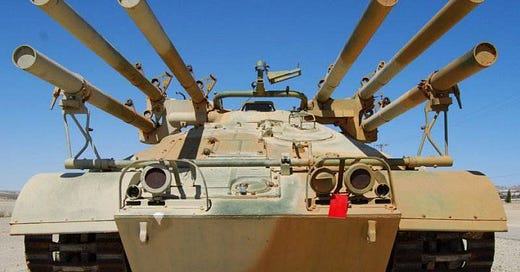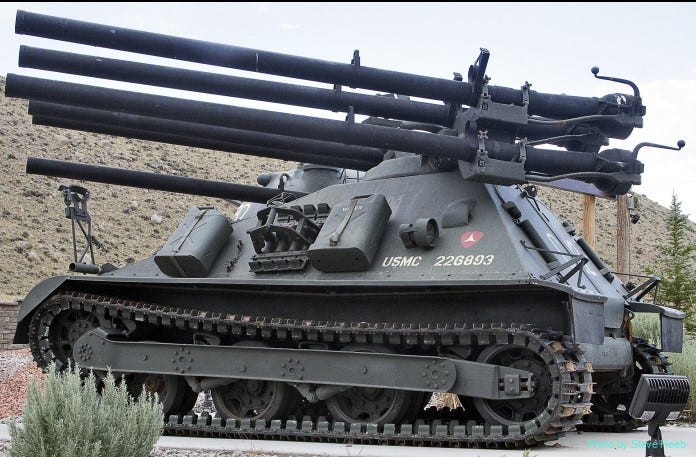My Marine Corps service began in 1978 and there were still plenty of Viet Nam veterans in the ranks. I happened to talk to one who had been on the Ontos. He said you couldn’t fire all of the guns at the same time or it would bend parts of the vehicle.
Wait – all the guns? Don’t tanks only have one? Ah, welcome, sir, to the world of the Thing, which is what “Ontos” means.
Designed in the 1950s as an air-portable tank destroyer, the vehicle mounted six (!) 106mm recoilless rifles. These are single-shot pieces, and the loader has to get out of the tank to reload them, so the only way to have quick multiple shots is to stack up more guns.
The Army lost interest but the Marine Corps embraced the ugly little tank, ordering 297 of them, designating it the M50. They saw service in Viet Nam and were apparently quite intimidating to the enemy. There are reports of NVA soldiers fleeing when an Ontos was brought up, which was probably a wise course of action. A 106mm is a decent round, although relatively short-ranged.
Four of the six guns were mated with a spotting rifle, a .50 caliber M8C. Note that this is not a .50 BMG round, being 22mm shorter, with a 77mm case vs. the BMG’s 99mm. They were tracers, loaded so that the point of impact matched that of the 106mm, and were designed to explode on impact with a puff of white smoke. If this round hit where the gunner wanted it to, then the 106 would also hit there.
The gunnery sergeant I talked to said that the technique was to fire the spotting round and have your finger on the trigger for the 106, and fire immediately if the hit was on target. That’s because a smart enemy soldier would immediately run from the spotting round because he knew that the much bigger round was coming.
Realistically, the tank had some serious flaws, one being that a crewmember had to get out to reload the guns. A recoilless rifle also has a huge backblast, which throws up dust and debris behind the gun, advertising its location to every enemy in the vicinity. That’s never a good idea. And finally, the armor was minimal, proof against small-arms fire but very vulnerable to mines and RPGs.
Viet Nam was the last of the Ontos. The TOW (Tube-launched, Optically tracked, Wire-guided) missile was fielded in 1970 to take the place of the M40 recoilless rifles, which is what the Ontos mounted.
All of the units were withdrawn from service in 1969-70, either given to the South Vietnamese or scrapped. Only about fourteen exist now in museums as a piece of weird armor history.






